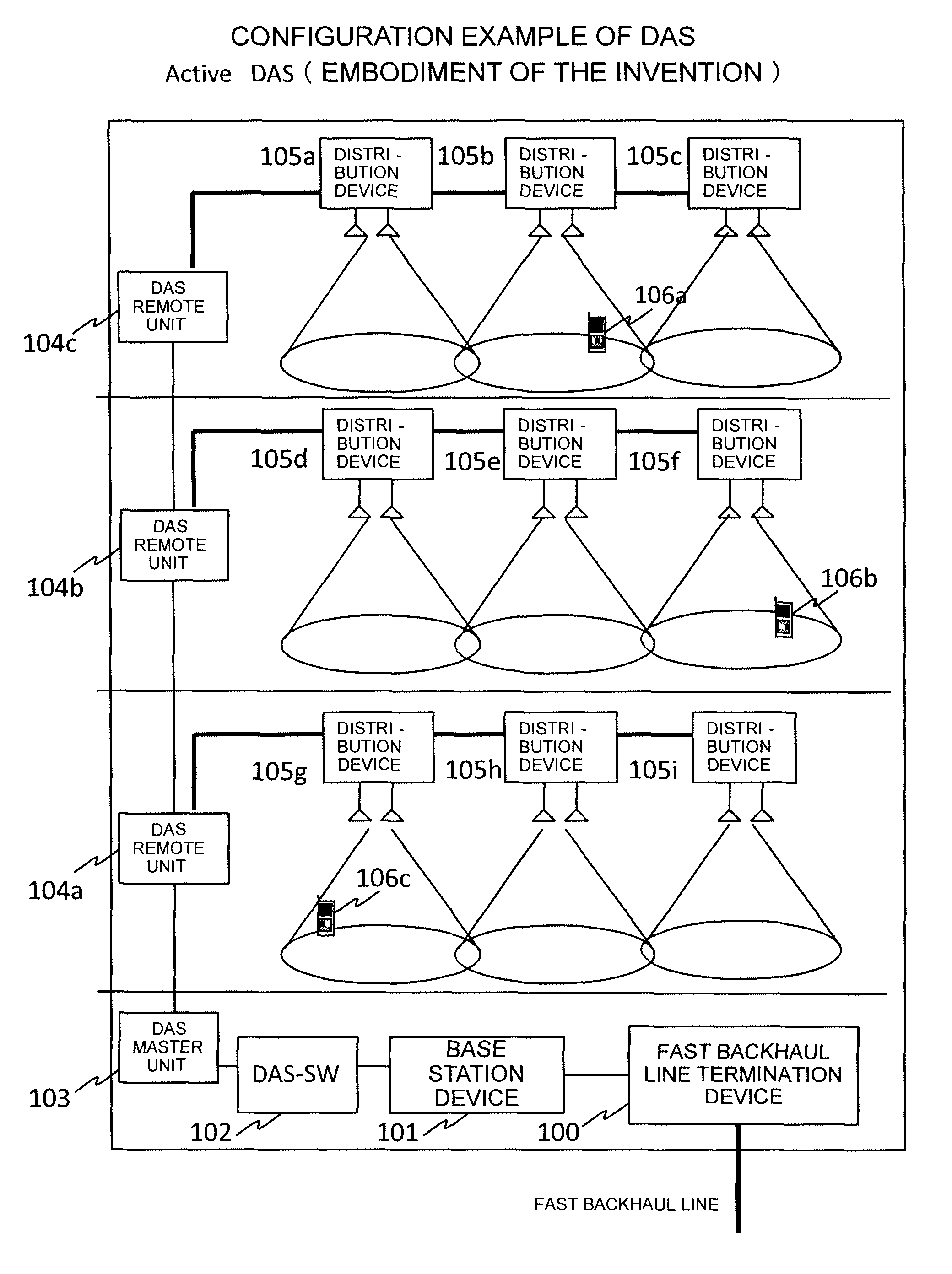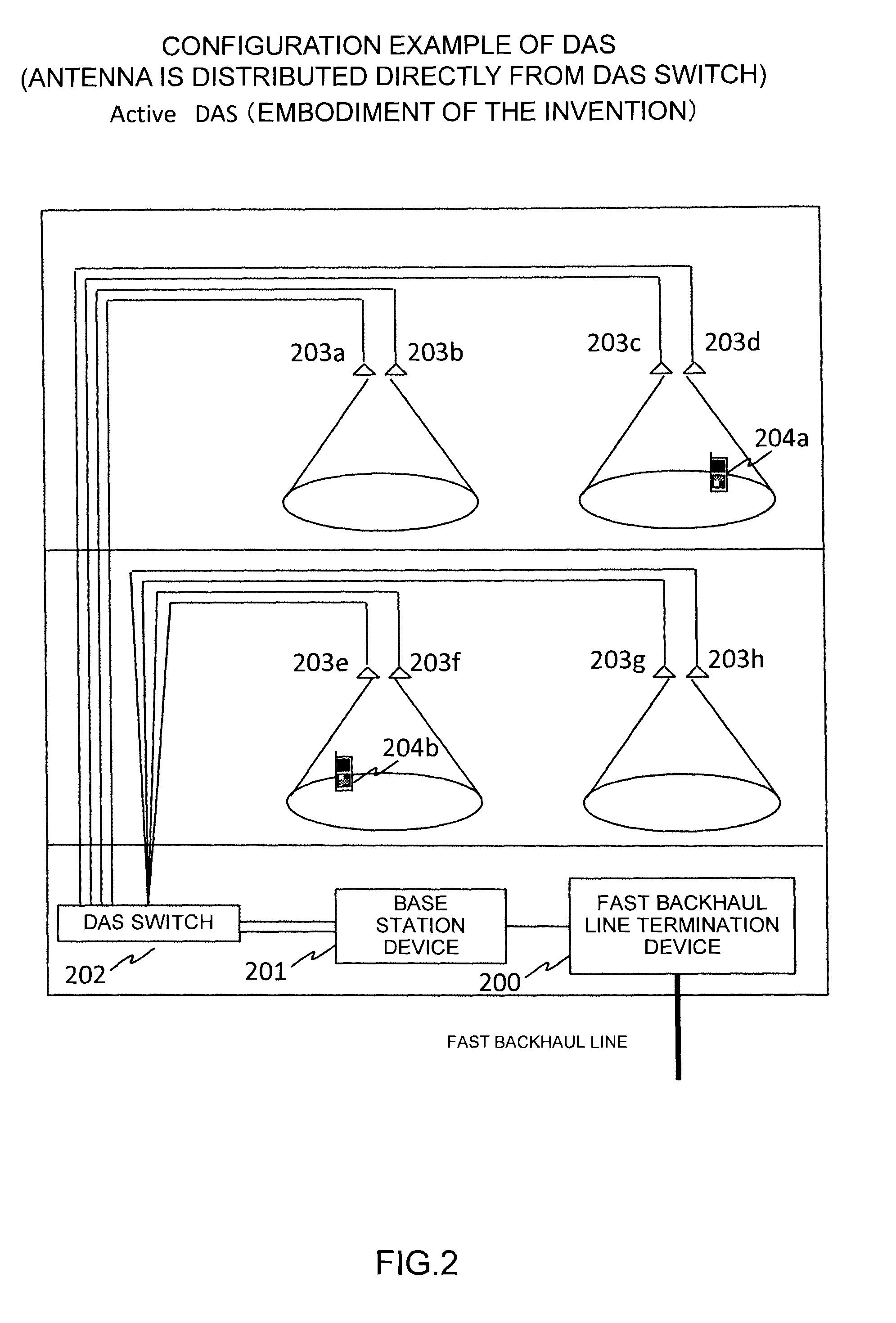Distributed antenna system, base station device, and antenna selection control method
a technology of antenna selection control and distribution antenna, which is applied in the direction of multi-antenna systems, substation equipment, spatial transmit diversity, etc., to achieve the effects of effective radio communication, improved overall system throughput, and reduced power consumption of terminals
- Summary
- Abstract
- Description
- Claims
- Application Information
AI Technical Summary
Benefits of technology
Problems solved by technology
Method used
Image
Examples
first embodiment
A. First Embodiment
1. System Configuration
[0080]FIG. 1 illustrates a configuration example of a DAS according to this embodiment. In a downlink, a data signal from a fast backhaul goes through a fast backhaul line termination device 100, and is subjected to encoding, modulation, and amplification processing according to a radio communication system in a base station device 101. A DAS switch 102 has an input end connected to an antenna port of the base station device 101, and an output end connected to a DAS master unit 103. A switching control between antenna ports of the base station device 101 and antennas of the distributed antenna system is conducted by the switch 102. A signal terminated and relayed by the DAS master unit 103 is relayed to DAS remote units 104a to 104c located at the respective floors of a building, and the signal is transmitted to distribution devices 105a to 105i according to the switching control of the DAS switch 102. Thereafter, a data signal is appropriat...
second embodiment
B. Second Embodiment
[0113]FIG. 7 is a flowchart illustrating an example (No. 2) of the MIMO changeover determination unit within the base station. FIG. 7 illustrates another embodiment of the flowchart of FIG. 5 in the first embodiment. A treatment of the antennas after the MIMO is applied is partially different from that in FIG. 5.
[0114]If the traffic to the terminal exceeds a given threshold value (Step 1), it is discriminated whether the MIMO is being currently applied, or not (Step 2). If the MIMO is being applied, and the anticipated communication speed is the threshold value or higher with the combination of the present antennas (Step 3), the present antennas are continuously used, and the MIMO communication is implemented (Step 8). In Step 2, if the MIMO is not being applied, or the anticipated communication speed is lower than the threshold value in Step 3, the processing is advanced to Step 4.
[0115]After Step 4, as in FIG. 5, the channel capacity of the respective antennas ...
third embodiment
C. Third Embodiment
[0116]FIG. 18 is a flowchart illustrating an example (No. 3) of the MIMO changeover determination unit within the base station. FIG. 18 illustrates another embodiment of the flowchart of FIG. 5 in the first embodiment. FIG. 18 illustrates a flowchart of the MIMO changeover determination unit when a specific terminal starts the MIMO communication, another terminal that conducts the SISO communication or the SIMO communication is re-allocated to the antenna less in the interference with the MIMO communication.
[0117]First, as in FIG. 5, after the subject terminal is selected (Step 1), it is determined whether the traffic volume of the terminal is the threshold value or higher, or not (Step 2). If the traffic volume is the threshold value or higher in Step 2, the channel capacity of the respective antennas is calculated according to the channel state information (CSI) (Step 3). Thereafter, the anticipated communication speed of the respective antennas is estimated (St...
PUM
 Login to View More
Login to View More Abstract
Description
Claims
Application Information
 Login to View More
Login to View More - R&D
- Intellectual Property
- Life Sciences
- Materials
- Tech Scout
- Unparalleled Data Quality
- Higher Quality Content
- 60% Fewer Hallucinations
Browse by: Latest US Patents, China's latest patents, Technical Efficacy Thesaurus, Application Domain, Technology Topic, Popular Technical Reports.
© 2025 PatSnap. All rights reserved.Legal|Privacy policy|Modern Slavery Act Transparency Statement|Sitemap|About US| Contact US: help@patsnap.com



